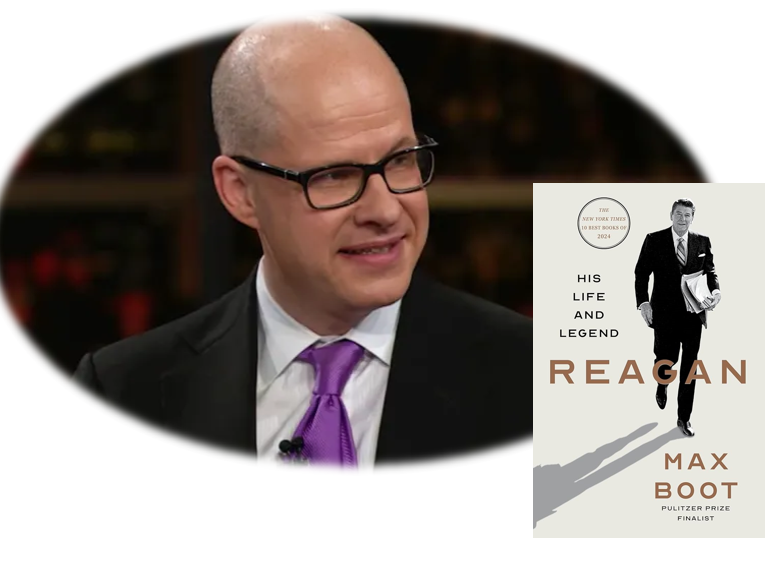Reagan

Max Boot’s Reagan: His Life and Legend is a meticulously researched and deeply insightful biography that aims to provide a comprehensive and nuanced portrait of one of the most influential and controversial figures in American political history. Boot, an established historian and political commentator, combines thorough historical research with an accessible narrative style to analyze Ronald Reagan’s life, his presidency, and the lasting legacy he has left on American politics.
The book traces Reagan’s evolution from his humble beginnings in Illinois to his rise in Hollywood, his transition into politics, and his two terms as president of the United States. Boot places a particular emphasis on Reagan’s transformation from a liberal Democrat to a conservative Republican, a shift that is often seen as emblematic of the broader political changes in post-World War II America. Boot does not just focus on Reagan’s political decisions but also explores his personality, communication skills, and ability to connect with the American people. His optimistic rhetoric, often referred to as “Reaganism,” has had a lasting impact on American conservatism, and Boot examines how Reagan cultivated his public persona to effectively navigate the political landscape.
One of the key strengths of the biography is Boot’s ability to blend the personal and political. He dives into Reagan’s early life, his time in Hollywood, and his political evolution, providing a comprehensive background that helps explain the motivations behind his decisions as president. Boot also covers Reagan’s domestic and foreign policies in great detail, highlighting both his successes and failures. While Reagan is often credited with ending the Cold War and implementing conservative economic policies, Boot does not shy away from critiquing his administration, including its handling of issues like the AIDS crisis and the Iran-Contra affair. These moments are presented not as footnotes but as key moments that reflect Reagan’s leadership style, or lack thereof in certain areas.
Boot also carefully explores Reagan’s approach to governance, emphasizing his pragmatic nature. While Reagan was ideologically conservative, he was also known for making deals with Democrats to get things done. This political pragmatism allowed him to enact significant pieces of legislation, such as tax cuts and a major arms control agreement with the Soviet Union. However, Reagan’s relationship with Congress and his approach to the political system were not always smooth. Boot delves into Reagan’s sometimes strained relationships with his own party, his advisors, and other members of the political establishment.
The book is not just a chronological recounting of events, but a nuanced exploration of Reagan’s character. Boot delves into the contradictions that defined Reagan as both a man and a politician. On the one hand, Reagan’s charisma and ability to connect with the public made him one of the most beloved presidents in modern history. On the other hand, his political decisions and leadership style were often deeply divisive. Boot does not shy away from criticizing some of Reagan’s more controversial policies, such as his initial indifference to the AIDS crisis, his handling of racial issues, and his tendency to overlook or downplay systemic inequalities in American society.
Critics have widely praised Reagan: His Life and Legend for its depth and balanced approach. The Washington Post describes the book as “magisterial,” highlighting Boot’s ability to balance the positive and negative aspects of Reagan’s presidency. Boot’s portrayal of Reagan is neither overly sentimental nor unduly critical, offering readers a rich, multi-dimensional view of the former president. The New York Times notes that Boot’s book is gripping, with a focus on the contradictions within Reagan’s character that make him such a fascinating figure in American history. Boot’s research is extensive, drawing on interviews, archival sources, and newly released documents to provide a fresh perspective on Reagan’s life and legacy.
While Boot’s biography offers a balanced assessment, it does not attempt to excuse some of the more problematic aspects of Reagan’s presidency. In particular, Boot addresses the darker side of Reagan’s tenure, such as his initial reluctance to address the AIDS epidemic, his policy of tax cuts that disproportionately benefited the wealthy, and his role in stoking racial tensions. At the same time, Boot also acknowledges Reagan’s achievements, including his role in the Cold War, his appeal to a broad swath of the American electorate, and his ability to reshape the Republican Party into a more conservative entity.
Boot also does a masterful job of contextualizing Reagan within the larger historical and political landscape. He situates Reagan not just within the framework of his presidency but within the larger currents of 20th-century American history, including the rise of the conservative movement, the changing nature of American politics, and the shift from postwar liberalism to a more conservative outlook. Reagan: His Life and Legend serves as both a biography and a reflection on the political era in which Reagan rose to prominence.
In conclusion, Reagan: His Life and Legend is an essential read for anyone interested in understanding the complexities of one of America’s most iconic and polarizing presidents. Boot’s biography provides a nuanced, critical, and well-researched look at Reagan’s life, his political career, and his lasting impact on American society and politics. It offers readers both a rich understanding of Reagan’s character and an informed perspective on his political legacy. Whether for scholars, political enthusiasts, or casual readers, this biography serves as a definitive work on one of the most transformative figures of the 20th century.



